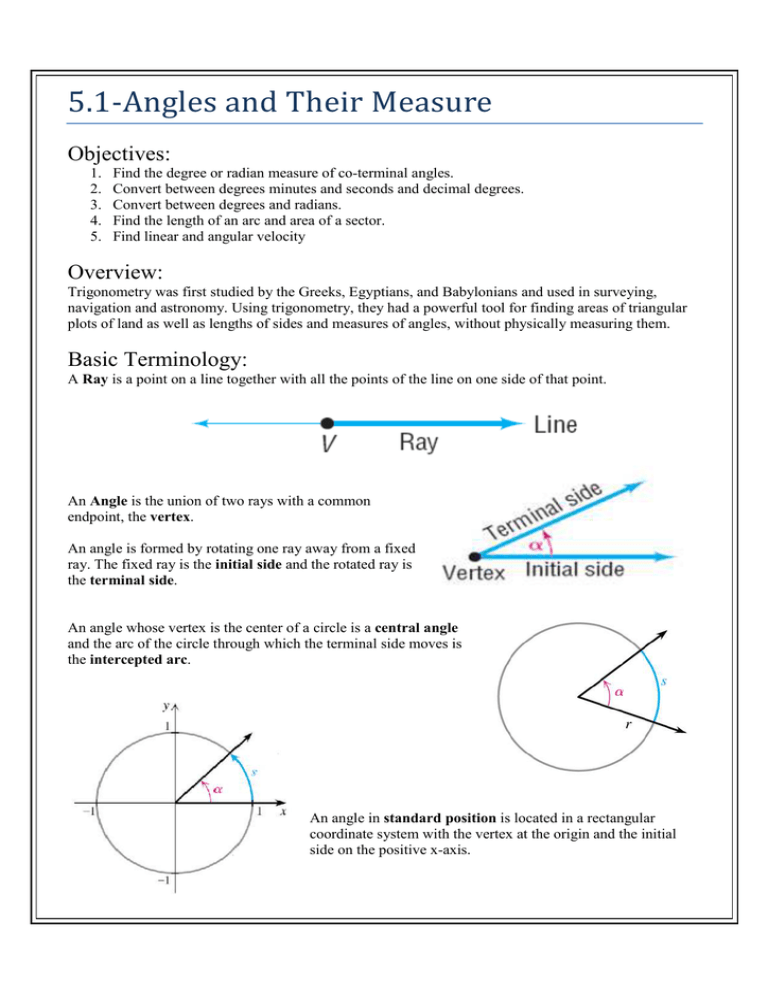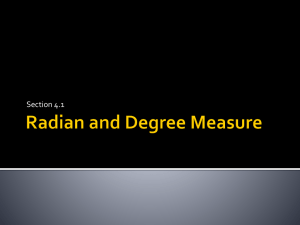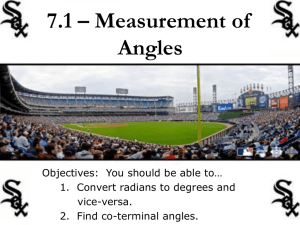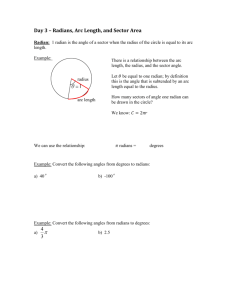Angles and Their Measure: Trigonometry Lesson
advertisement

5.1-Angles and Their Measure Objectives: 1. 2. 3. 4. 5. Find the degree or radian measure of co-terminal angles. Convert between degrees minutes and seconds and decimal degrees. Convert between degrees and radians. Find the length of an arc and area of a sector. Find linear and angular velocity Overview: Trigonometry was first studied by the Greeks, Egyptians, and Babylonians and used in surveying, navigation and astronomy. Using trigonometry, they had a powerful tool for finding areas of triangular plots of land as well as lengths of sides and measures of angles, without physically measuring them. Basic Terminology: A Ray is a point on a line together with all the points of the line on one side of that point. An Angle is the union of two rays with a common endpoint, the vertex. An angle is formed by rotating one ray away from a fixed ray. The fixed ray is the initial side and the rotated ray is the terminal side. An angle whose vertex is the center of a circle is a central angle and the arc of the circle through which the terminal side moves is the intercepted arc. An angle in standard position is located in a rectangular coordinate system with the vertex at the origin and the initial side on the positive x-axis. The measure m (α ) of an angle indicates the amount of rotation of the terminal side from the initial side. It is found using any circle. The circle is i divided into 360 equal arcs and each arc is one degree. Degree Measure of an Angle: Angle The degree measure of an angle is the number of degrees in the intercepted arc of a circle centered at the vertex. The degree measure is positive if the rotation is counterclockwise and negative if the rotation is clockwise. Angles are typically denoted using Greek letters such as, Alpha α , Beta β or Theta θ . Types of Angles: Acute angles are between 0 and 90 degrees. Obtuse angles are between 90 and 180 degrees. Right angles are 90 degrees. Straight angles are 180 degrees. The rectangular coordinate system is divided into four quadrants as shown in the diagram to the right. The terminal side of an angle will either lie in one of the four quadrants or on one of the axes. Quadrantal angles have the terminal side on one of the axes. Example: Draw each of the following angles and identify the quadrant the terminal side lies in. a. 45 0 b. − 90 0 c. 225 0 d. 405 0 Solution: a. Quadrant 1 b. Quadrantal c. Quadrant III d. Quadrant I Coterminal Angles: Coterminal angles are angles in standard position that have the same initial side and the same terminal side. Any two coterminal angles have degree measures that differ by a multiple of 360 degrees. 270 and -90 are coterminal. Notice that they differ by 360 degrees. 270 - (-90) = 360 Example: Name two angles, one positive and one negative that are coterminal to 320 degrees. Solution: Add and subtract 360 degrees from the angles measure. 1. 320 – 360 = -40 degrees 2. 320 + 360 = 680 degrees Example: Determine if the angles -120 and 600 are coterminal. Solution: If these two angles differ by a multiple of 360, then they are coterminal. If n is an integer in the equation α + 360 n = β , then the angles are coterminal. − 120 + 360n = 600 360n = 720 n=2 Since n is an integer the angles are coterminal. Example: Determine if the angles -960 and 1040 are coterminal. Solution: If these two angles differ by a multiple of 360, then they are coterminal. If n is an integer in the equation α + 360 n = β , then the angles are coterminal. − 960 + 360n = 1040 360n = 2000 n = 5.556 Since n is not an integer the angles are not coterminal. Convert Between Decimal and DMS Measures: Angles may be written in degrees minutes and seconds or as decimal degrees. To convert from one unit to the other we use the following relationships: 1 degree = 60 minutes 1 minute = 60 seconds 1 degree = 3600 seconds Example: Convert 32 0 45 ' to decimal degrees. Solution: Use the above relationships as ratios to convert 45 minutes to degrees. 45 min× 1 deg 45 = deg = .75 deg 60 min 60 Therefore 32 0 45 ' = 32.75 0 Example: Convert 123 0 52 ' 37 "" to decimal degrees. Solution: Use the above relationships as ratios to convert 37 seconds to minutes. 37 sec× 1 min 37 = min = 0.617 min 60 sec 60 123 0 52 ' 37 "" = 123 0 52.617 ' . Now convert 52.617 minutes to degrees. 52.617 min× 1 deg 52.617 = deg = 0.877 deg 60 min 60 123 0 52 ' 37 "" = 123 0 52.617 ' = 123.877 0 Example: Convert 154.243 0 to dms. Solution: 0.243 deg× 60 min = 14.580 min 1deg 154.243 0 = 154 014.580 ' Now convert 0.580’ to seconds. 0.580 min× 154.243 0 = 154 014.580 ' = 154 014 ' 34.8 '' 60 sec = 34.80 sec 1 min Radian Measure of Angles: The radian measure of the angle α in standard position is the directed length of the intercepted arc on the unit circle. Radian measure is used extensively in scientific fields and results in simpler formulas in trigonometry and calculus. Radian measure is a directed length because it is positive or negative depending on the direction of the terminal side. Radian measure is a real number without any dimension. Converting Between Radian Measure and Degrees: The circumference of the unit circle is C = 2rπ = 2π . If the terminal side rotates 360 degrees the length of the intercepted arc is 2π . Therefore an angle measure of 360 degrees has a radian measure of 2π radians. This relation simplifies as follows: 180 0 = π .rad . This conversion factor can be used to convert between radian measure and degree measure. Example: Convert 45 degrees to radians Solution: Use the conversion factor 180 0 = π .rad . as a ratio such that units cross cancel. 45 deg× π .rad 180 deg = π 4 rad Example: Convert -120 degrees to radians Solution: Use the conversion factor 180 0 = π .rad . as a ratio such that units cross cancel. − 120 deg× π .rad 180 deg =− 2π rad 3 Example: Convert 5π radians to degrees 6 Solution: Use the conversion factor 180 0 = π .rad . as a ratio such that units cross cancel. 180 deg 5π rad × = 150 deg 6 πrad Example: Convert − 7π radians to degrees 2 Solution: Use the conversion factor 180 0 = π .rad . as a ratio such that units cross cancel. − 7π 180 deg rad × = −630 deg 2 πrad Finding Coterminal Angles using Radian Measure: Any two coterminal angles in radian measure differ by a multiple of 2π . Notice that they differ by a multiple of 2π radians. 3π π 4π − − = = 2π 2 2 2 3π π and − are coterminal. 2 2 Example: Name two angles, one positive and one negative that are coterminal to 3π radians. 4 Solution: Add and subtract 2π radians from the angles measure. 3π 11π radians + 2π = 4 4 3π 5π 2. radians − 2π = − 4 4 1. Example: Determine if the angles − 5π 11π radians and radians are coterminal. 4 4 Solution: If these two angles differ by a multiple of 2π then they are coterminal. If n is an integer in the equation α + 2π .n = β , then the angles are coterminal. 5π 11π − + 2π .n = 4 4 16π 2π .n = 4 n = 2π Since n is an integer the angles are coterminal. Radian Measures of Common Angles: The following diagram presents the radian measure of angles that are frequently used in trigonometry. It is strongly advised that you keep this diagram available when working on trigonometry problems. The angles in the Quadrant I and the Quadrantal Angles should be memorized. Arc Length: Radian measure of a central angle of a circle can be used to easily find the length of the intercepted arc of the circle. The length s of an arc intercepted by a central angle of α radians on a circle of radius r is given by: s = αr Where s is the arc length, r is the radius and α is the measure of central angle. In general, a central angle in a circle of radius r intercepts an arc whose length is a fraction of the circumference of the circle. Example: Find the length of the arc intercepted by a central angle of 7π in a circle of radius 7 cm. 9 Round to two decimal places. Solution: Use the arc length formula. s = αr 7π s= ×7 9 s = 17.10 The measure of the arc is 17.10 cm. Example: Find the radian measure of the central angle α which intercepts a 30 cm arc in a circle of radius 10 cm. Round to one decimal place, if necessary. Solution: Use the arc length formula to solve for α s = αr 30 = α × 10 α =3 The measure of the central angle is 3 radians. Example: A car wheel has a 16-inch radius. Through what angle (to the nearest tenth of a degree) does the wheel turn when the car rolls forward 3 ft? Solution: Use the arc length formula to solve for α in radians. s = αr 36 = α × 16 α = 2.25 Now convert from radians to degrees. α = 2.25rad × 180 deg = 128.9 πrad When the car rolls forward 3 ft, the wheel turns through an angle of 128.9 degrees. Example: A satellite photographs a path on the surface of the Earth that is 2500 miles wide. Find the measure of the central angle in degrees that intercepts an arc 2500 miles on the surface of the Earth (radius 3950 miles). Solution: To determine the measure of the central angle, you can use the fact that in a circle of radius r, a central angle of α radians intercepts an arc length of s. Use the formula: s = αr Let s = 2500 and r = 3950. s = αr 2500 = α (3950) 2500 3950 α = 0.6329 α= Remember, the angle is measured in radians. To obtain the answer in degrees, multiply by 180 π . 0.6329 × 180 π = 36.26 Therefore, the measure of the central angle is 36.26 degrees. Linear Velocity: If a point is in motion on a circle of radius r through an angle of α radians in time t, then its linear velocity v is given by s v= t where s is the arc length determined by s = αr. Linear Velocity is a measure linear distance along an arc over a period of time. Angular Velocity: If a point is in motion on a circle through an angle of α radians in time t, then its angular velocity ω is given by ω= α t Angular velocity is a measure of how a central angle changes over a period of time. Example: A windmill for generating electricity has a blade that is 30 feet long. Depending on the wind, it rotates at various velocities. Find the angular velocity in rad/sec. for the top of the blade if the windmill is rotating at a rate of 50 rev/sec. Solution: Use the cancellation of units and the fact that 2π radians = 1 rev. ω= α t 50rev 2π .rad 100π .rad ω= × = sec . rev sec . ω = 314.15rad / sec The angular velocity is 314.15 radians second. Linear Velocity in Terms of Angular Velocity: If v is the linear velocity of a point on a circle of radius r, and ω is its angular velocity, then v = rω Example: A wheel is rotating at 2 radians/sec, and the wheel has a 24-inch diameter. To the nearest foot per minute, what is the velocity of a point on the rim? Solution: We are given the angular velocity ω = 2rad / sec and the radius r = 12. v = rω v = 12(2) = 24in / sec This value needs to be converted into the appropriate units of feet/min. 24in 1 ft 60 sec × × = 120 ft / min sec 12in 1 min Example: The blade on a typical table saw rotates at 3,600 rpm. What is the difference in linear velocity in inches per second of a point on the edge of an 18-inch diameter blade and a 6-inch diameter blade? Solution: Find the angular velocity of the blade given that the blade rotates at 3,600 rpm. ω= α t 3,600.rev 2π .rad 1 min × × ω= min . rev 60 sec ω = 120.π .rad / sec . Now use the formula v = r.ω to obtain the linear velocity for each point. v = r.ω v = 9(120π ) v = 1,080π .in. / sec . v = r.ω v = 3(120π ) v = 360π .in. / sec . Find the difference between these two velocities: 1080π − 360π = 720.in. / sec . The difference in linear velocity is 720.in. / sec . Problem: The propeller of a Cessna Caravan is 106-inches in diameter and rotates at 1,800 rpm under normal cruising flight. Determine the angular velocity of the propeller. What is the difference in linear velocity in inches per second of a point on the tip of the propeller and a point 6-inch from the propeller hub (vertex)? The solution should be written in exact form. Solution: Find the angular velocity of the blade given that the blade rotates at 1,800 rpm. ω= α t 1,800.rev 2π .rad 1 min × × ω= min rev 60 sec ω = 60π .rad / sec . Now use the formula v = r.ω to obtain the linear velocity for each point. v = r.ω v = 53(60π ) v = 3,180π .in. / sec . v = r.ω v = 6(60π ) v = 360π .in. / sec . Find the difference between these two velocities: 3,180 − 360 = 2,820.π .in. / sec. The difference in linear velocity is 2,820.π .in. / sec .


